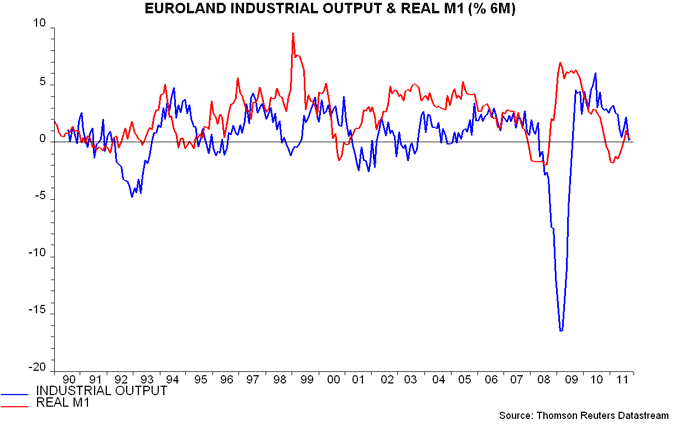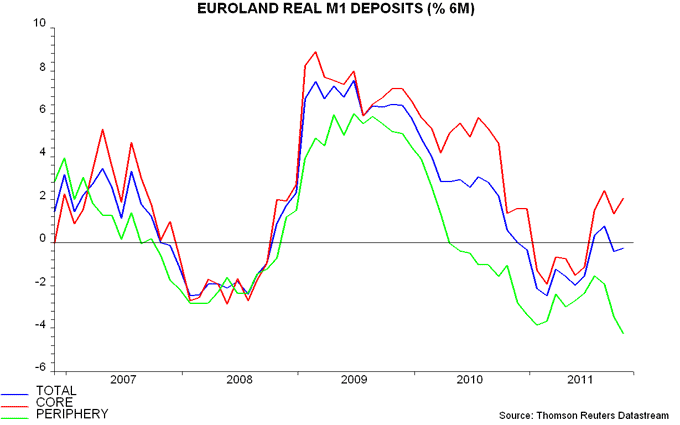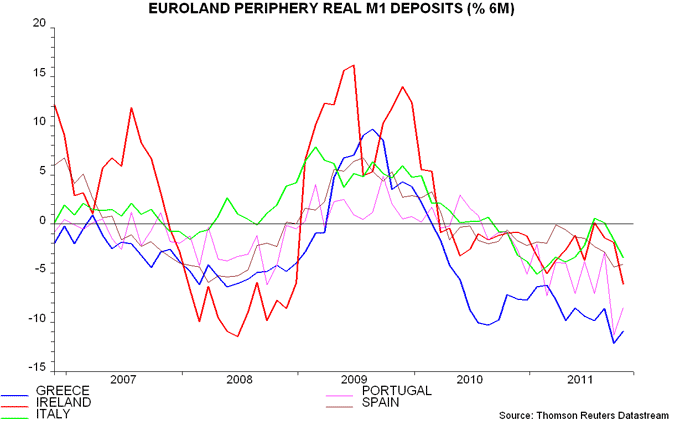Eurozone money numbers confirm peripheral slump
Eurozone monetary statistics for October are weak but the bigger story is a widening core / periphery divergence, with an accelerating decline in real M1 deposits in the latter group suggesting that economies remain locked on course for a depression barring radical ECB action.
M1 – comprising currency in circulation and overnight deposits – is a better leading indicator than the broader M3 measure, probably because households and firms increase their holdings of more liquid forms of money before raising spending. The six-month rate of change of Eurozone-wide real M1 turned negative in late 2010, warning that a recession would develop during 2011. The six-month change has since returned to positive territory but remained weak at just 0.3% (0.5% annualised) in October – see first chart.
The ECB publishes a country breakdown of overnight deposits but not currency. Region-wide real M1 deposits fell by 0.3% in the six months to October but this conceals a 2.1% rise in core economies (i.e. Germany, France, Netherlands, Austria, Belgium, Luxembourg) offset by a record 4.2% decline (8.3% annualised) in the periphery (Italy, Spain, Greece, Portugal, Ireland) – second chart. Peripheral weakness partly reflects capital flight into the core or out of the euro area altogether but this does not alter the economic implications – money leaving M1 accounts will not be spent domestically.
The annualised fall in the six months to October was 20.7% in Greece, 16.3% in Portugal, 11.8% in Ireland, 8.1% in Spain and 6.7% in Italy. The Portuguese reading confirms that last month’s slump was no fluke while Irish and Italian numbers have deteriorated markedly since the summer, when there were tentative signs of real M1 deposits stabilising – third chart.




Reader Comments (3)
Simon: I've spent a lot of time looking at this area through the life of the euro. One thing that concerns me is that "Peripheral weakness partly reflects capital flight into the core or out of the euro area altogether but this does not alter the economic implications – money leaving M1 accounts will not be spent domestically." might not be true. If Mrs Papadapoulos puts her euro into Deutsche Frankfurt, say, she can still settle her credit card with them. Let's be clear, I've seen issues here for years and there is a slow bank run going on that the ECB is having to offset at an ever-growing rate, but I think national interpretation of M statistics in the euro area is now harder than it was.
Does capital flight into the core or out of the eurozone (UK or US I would presume) mean that the monetary data is overestimating any improvement in these areas?
Thank you for your comments and sorry for the delay in replying.
DrHans: You are, of course, correct. However, the act of transferring funds out of a country probably indicates extreme pessimism, likely to be reflected in lower domestic spending.
Simon: Assuming that transferred funds represent "dead" money, the boost to core money supply growth from capital flight is indeed artificial. The same applies to any positive impact on the US numbers but the UK money supply definition excludes foreign deposits.